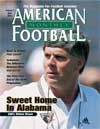AMERICAN FOOTBALL MONTHLY THE #1 RESOURCE FOR FOOTBALL COACHES
Article CategoriesAFM Magazine
|
Level the Playing Fieldby: Sam McCorkleHead coach, Tennessee Martin © More from this issue When we came to Martin a year ago, we knew that we were nearly starting from scratch. We only had thirty-eight players on our team for our first spring practice. Knowing that our numbers were low and we were going to have to play a very tough I-AA schedule with many young players, we had to try and find a way to do something different that would level the playing field. Having seen the Academies become very successful with less talent than their opposition by playing option football, and studying closely some of the things that Rice University was doing to move the ball and score points, we felt that the triple option was a great way to go. We also visited with Coach Gerry Dinardo and studied the I-Bone, which he so effectively employed at Vanderbilt and Colorado. We felt that this strategy would help us with recruiting. We could....The full article can only be seen by subscribers.
|
|
|||||||
| HOME |
MAGAZINE |
SUBSCRIBE | ONLINE COLUMNISTS | COACHING VIDEOS |
Copyright 2025, AmericanFootballMonthly.com
All Rights Reserved





